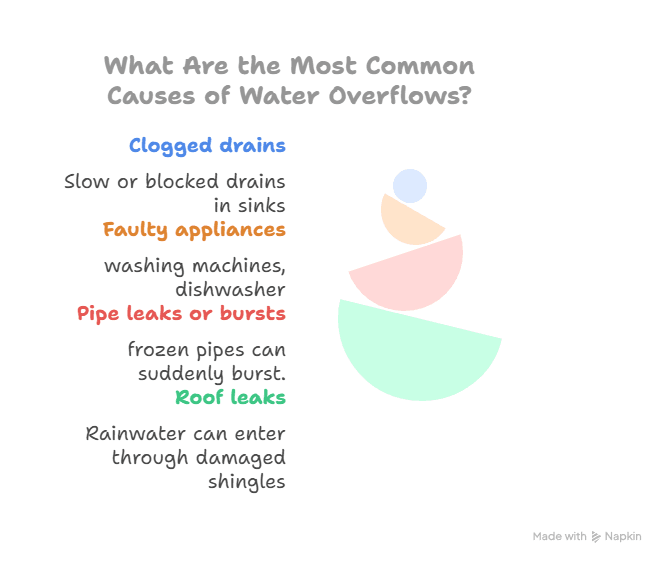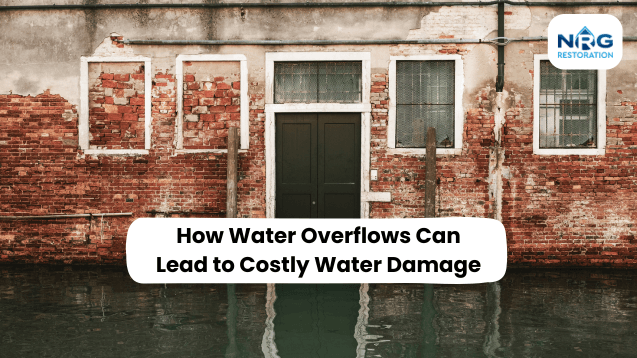Water is essential for life, but when it goes where it shouldn’t, it can turn a safe home into a disaster zone. How water overflows can start small like a dripping sink or a minor leak but quickly escalate into major damage that costs thousands to repair. Understanding the risks, signs, and solutions is critical to protecting your home and your peace of mind.
At NRG Restoration, we help homeowners manage water overflow issues quickly and efficiently, reducing damage and restoring homes safely.
What Exactly Happens When Water Overflows in Your Home?
How water overflows usually occurs when water escapes from its normal containment like sinks, bathtubs, toilets, or pipes and spreads across your floors and walls. The effects are not always immediately visible, but the damage can worsen over time.
When water spills over:
- Structural damage: Wood, drywall, and insulation absorb water and weaken.
- Mold growth: Even small amounts of water can create mold in 24–48 hours.
- Electrical hazards: Water reaching outlets or appliances can be dangerous.
- Property damage: Furniture, carpets, and personal items may become ruined.
These risks show why timely action is crucial. Ignoring small overflows can lead to bigger issues that are expensive and difficult to fix.
What Are the Most Common Causes of Water Overflows?

How water overflows can happen for several reasons. Some are easy to fix, others require professional help. Here are the most common causes:
Before a major disaster occurs, it’s important to identify the cause of water overflow in your home.
- Clogged drains: Slow or blocked drains in sinks, tubs, or toilets cause water to spill over.
- Faulty appliances: Dishwashers, washing machines, and water heaters can malfunction.
- Pipe leaks or bursts: Old, corroded, or frozen pipes can suddenly burst.
- Roof leaks: Rainwater can enter through damaged shingles or gutters.
Knowing these causes can help you prevent overflows before they turn into costly repairs.
How Can You Detect Early Signs of Water Overflows?
Spotting early signs is key to preventing expensive water damage. How water overflows often begins subtly, so homeowners must be alert.
Detecting water overflow early can save you thousands in repairs and prevent long-term damage.
- Unusual water stains: Look for discoloration on ceilings or walls.
- Mold or mildew smell: Even before visible mold appears, a musty odor can indicate moisture.
- Pooling water: Puddles near sinks, appliances, or bathroom fixtures are warning signs.
- Dripping or running sounds: Listen for unexpected water sounds when appliances are off.
If you notice any of these signs, contact professionals immediately to reduce damage.
How Does Water Overflow Lead to Structural Damage?
How water overflows may seem minor at first, but it can severely affect your home’s structure. Water soaks into wood, drywall, and foundations, compromising their strength.
Structural damage may not be obvious immediately but can worsen if left untreated.
- Weakened wood: Floorboards and studs can warp or rot.
- Drywall damage: Walls may bubble, peel, or crumble.
- Foundation issues: Long-term water exposure can lead to cracks or settling.
Quick intervention is essential to prevent costly repairs and maintain home safety. NRG Restoration can assess the damage and provide targeted solutions.
Can Water Overflow Cause Mold and Health Problems?
Yes. Mold thrives in damp environments, and how water overflows plays a major role in creating such conditions.
Mold not only damages property but also poses serious health risks, including allergies and respiratory issues.
- Mold growth: Moist areas promote rapid mold growth in as little as 48 hours.
- Health risks: Mold spores can trigger asthma, allergies, and infections.
- Hidden mold: Water that seeps into walls or under floors can produce unseen mold.
Addressing overflows promptly prevents mold growth. NRG Restoration offers mold remediation services as part of water damage restoration.
What Are the Immediate Steps to Take During a Water Overflow?
When a water overflow occurs, quick action can minimize damage. Here’s what you can do while waiting for professional help:
Acting fast is crucial. These steps reduce water penetration and prevent further damage.
- Turn off the water source: Shut off valves to stop further overflow.
- Unplug electrical appliances: Avoid electric shocks.
- Remove valuables: Move furniture and personal items away from water.
- Absorb water: Use towels or a wet/dry vacuum if safe.
While these actions help, professional restoration ensures full recovery and prevents long-term damage.
How Can NRG Restoration Help With Water Overflows?
Professional help is often necessary, especially for severe overflows. How water overflows can lead to hidden damage, and NRG Restoration specializes in safe, efficient restoration.
Our services go beyond simple cleanup. We focus on thorough water removal, structural repair, and mold prevention.
- Water extraction: Rapid removal of water using professional-grade equipment.
- Drying and dehumidification: Prevents structural damage and mold growth.
- Sanitization: Kills bacteria and prevents odors.
- Repairs and restoration: Restores floors, walls, and furniture to their pre-damage state.
Our team ensures your home is safe, dry, and fully restored, giving you peace of mind.
How Can Homeowners Prevent Water Overflows?
Preventing overflows is better than repairing them. How water overflows can be reduced with simple, consistent maintenance.
Proactive measures protect your home and save money in the long run.
- Regular inspections: Check pipes, drains, and appliances regularly.
- Clean gutters: Prevent water backup from clogged gutters.
- Install overflow alarms: Alerts you before a small leak becomes a major issue.
- Routine maintenance: Service water heaters, washing machines, and plumbing systems.
Preventive care is your first line of defense. NRG Restoration also offers guidance for home maintenance to minimize future risks.
What Are the Costs of Ignoring Water Overflows?
Ignoring how water overflows can lead to major expenses:
Small overflows seem harmless, but their long-term impact can be costly.
- Repair costs: Structural, electrical, and flooring repairs add up quickly.
- Mold remediation: Untreated mold can cost thousands to remove.
- Property loss: Furniture, electronics, and personal items may be ruined.
- Insurance complications: Delay in reporting damage can affect claims.
Timely intervention reduces costs and prevents stress. NRG Restoration acts quickly to save your home and belongings.
Conclusion
How water overflows can cause serious, costly damage if not addressed promptly. From structural harm to mold growth, even minor overflows can escalate quickly. Taking quick action, maintaining your home, and knowing when to call professionals is essential.
NRG Restoration provides complete water damage solutions, from extraction to repair. Our team ensures your home is restored safely and efficiently. Don’t wait for small overflows to turn into major disasters contact NRG Restoration today for expert water damage help.
Call or visit NRG Restoration now to protect your home and prevent costly water damage. Our experienced team is ready to restore your property with fast, reliable, and professional service.
